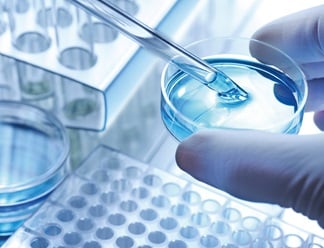HARTMANN SCIENCE CENTER

SARS-CoV-2 (Severe Acute Respiratory Syndrome CoronaVirus 2) belongs to the coronavirus family (Coronaviridae). Coronaviruses are spherical enveloped viruses. In humans, they can cause gastrointestinal and respiratory infections - for example bronchitis, colds or SARS (Severe Acute Respiratory Syndrome).
The clinical picture caused by SARS-CoV-2 is referred to as COVID-19 (Coronavirus Disease 2019). The first cases were reported in December 2019 in Wuhan (China). Other known representatives of the coronaviruses are SARS coronavirus (SARS-CoV) and MERS coronavirus (MERS = Middle East Respiratory Syndrome).
In everyday situations, SARS-CoV-2 is mainly transmitted via small droplets that are produced when speaking, coughing and sneezing and can be transferred to other persons via their mucous membranes of the nose, mouth and possibly the eyes (droplet infection).
Aerosol transmission (via droplet nuclei smaller than 5 µM) are possible and probably play a role particularly when occupying smaller rooms with poor ventilation. In the medical environment, all aerosol-producing procedures (e.g. intubation, bronchoscopy or dental procedures) must be considered to be high risk. Transmission through contaminated surfaces (contact transmission) is also likely, particularly in the immediate vicinity of infected persons. In COVID-19 patients, PCR-positive faeces samples were also identified occasionally.
Replicating viruses could be detected in experimentally generated aerosols for up to three hours. On inanimate surfaces their number decreased exponentially over time under experimental conditions. Current research results indicate that high temperatures and high humidity can significantly reduce the transmission of SARS-CoV-2.
Previous laboratory studies have shown that various coronaviruses of the Coronaviridae family can survive after drying on different surfaces or when diluted in water. Temperature, humidity and the condition of the surface material play an important role here.
To inactivate coronaviruses and SARS-CoV-2, disinfectants which are at least effective against enveloped viruses should be used. Disinfectants with the effective ranges ”limited spectrum antiviral activity" and "virucidal" can also be used. BODE disinfectants for Hands, Skin, Surfaces and Instruments meet these requirements and can be used. Due to the different applications, the recommended contact times should be observed.
Reference:
1European Center for Disease Prevention and Control. COVID-19 pandemic
2Robert Koch Institute. COVID-19 (Coronavirus SARS-CoV-2). Accessed on 10.08.2020
3Wang J et al. High Temperature and High Humidity Reduce the Transmission of COVID-19 (March 9, 2020).
4Geller C et al. Human Coronaviruses: Insights into Environmental Resistance and Its Influence on the Development of New Antiseptic Strategies. Viruses 2012: 4, 3044-3068; doi:10.3390/v4113044.